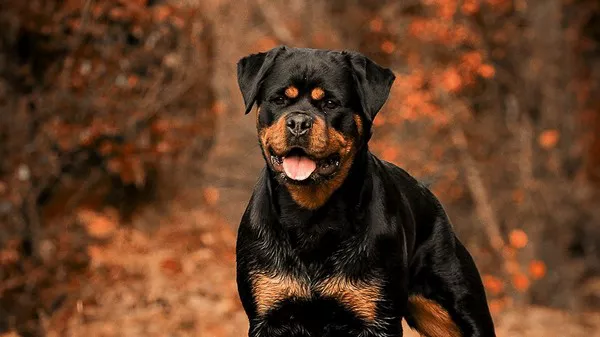The German Rottweiler is a powerful and intelligent breed of dog that is known for its loyalty and protective nature. These dogs are easily recognizable by their muscular build, black and tan coat, and distinctive facial features. In this article, we will discuss what a German Rottweiler looks like and what to expect when adopting one.
Physical Characteristics
The German Rottweiler is a large and powerful breed of dog. These dogs have a broad chest, strong legs, and a powerful jaw. Males can weigh between 95 and 135 pounds, while females typically weigh between 80 and 100 pounds. These dogs stand between 22 and 27 inches tall at the shoulder.
One of the most distinctive physical characteristics of the German Rottweiler is its muscular build. These dogs have a broad and deep chest, which gives them a powerful appearance. They also have strong legs and a sturdy frame, which allows them to move with ease and grace.
The coat of a German Rottweiler is black with tan markings. The tan markings are typically located on the face, chest, and legs. The coat is short and dense, which makes it easy to maintain with regular brushing.
The tail of a German Rottweiler is typically docked, although this practice is becoming less common in some countries. The tail is usually docked at the first or second joint, which gives the dog a balanced and symmetrical appearance.
Facial Features
The German Rottweiler has several distinctive facial features that set it apart from other breeds. These dogs have a broad, flat skull and a well-defined stop. The stop is the indentation between the forehead and the muzzle, which gives the dog a distinctive and imposing appearance.
The ears of a German Rottweiler are medium-sized and triangular, and they typically fold forward. The ears are set high on the head and are located just above the eyes. This gives the dog a distinctive and alert expression.
The eyes of a German Rottweiler are almond-shaped and dark brown in color. They have a serious and intelligent expression that is characteristic of the breed. The eyes are set deep in the skull, which gives the dog a distinctive and imposing appearance.
The muzzle of a German Rottweiler is broad and powerful, with a black nose and strong jaws. The jaws are powerful enough to crush bones, which makes the dog an excellent guard dog. The muzzle is also short and square, which gives the dog a distinctive and imposing appearance.
Temperament
The German Rottweiler is known for its loyalty, intelligence, and protective nature. These dogs are highly trainable and excel in obedience training, agility, and other dog sports. They are also known for their strong work ethic and their willingness to please their owners.
Despite their imposing appearance, German Rottweilers are typically friendly and affectionate with their families. They are protective of their owners and can be wary of strangers, which makes them excellent guard dogs.
However, it’s important to note that the temperament of a German Rottweiler can vary depending on the individual dog and its upbringing. Proper socialization and training are essential for ensuring that these dogs are well-behaved and well-adjusted.
Health Concerns
Like all breeds of dogs, German Rottweilers are prone to certain health issues. Some of the most common health concerns for this breed include:
Hip Dysplasia
Hip dysplasia is a genetic condition that affects the hip joints. It can cause pain, stiffness, and lameness in affected dogs. German Rottweilers are prone to hip dysplasia, so it’s important to choose a breeder who screens their dogs for this condition.
Elbow Dysplasia
Elbow dysplasia is a genetic condition that affects the elbow joints. It can cause pain, lameness, and arthritis in affected dogs. German Rottweilers are also prone to elbow dysplasia, so it’s important to choose a breeder who screens their dogs for this condition.
Bloat
Bloat is a potentially life-threatening condition that can affect large breeds of dogs. It occurs when the stomach fills with gas and twists on itself, cutting off blood flow to the organs. German Rottweilers are at increased risk for bloat, so it’s important to feed them small, frequent meals and avoid exercising them immediately after eating.
Hypothyroidism
Hypothyroidism is a condition that occurs when the thyroid gland does not produce enough thyroid hormone. This can lead to weight gain, lethargy, and other health issues. German Rottweilers are prone to hypothyroidism, so it’s important to have their thyroid levels checked regularly.
Cancer
Like all breeds of dogs, German Rottweilers are prone to certain types of cancer. Some of the most common types of cancer in this breed include bone cancer, lymphoma, and hemangiosarcoma. Regular veterinary checkups and early detection are essential for treating cancer in dogs.
Training and Exercise
The German Rottweiler is a highly trainable breed that excels in obedience training, agility, and other dog sports. These dogs are also highly intelligent and require mental stimulation in addition to physical exercise.
It’s important to start training and socializing a German Rottweiler at a young age. This will help to ensure that the dog is well-behaved and well-adjusted. Regular exercise is also important for keeping these dogs healthy and happy.
Conclusion
In conclusion, the German Rottweiler is a distinctive and imposing breed of dog that is known for its loyalty, intelligence, and protective nature. These dogs have a muscular build, black and tan coat, and distinctive facial features that set them apart from other breeds. While they can be prone to certain health issues, with proper care and attention, German Rottweilers can make excellent companions and family pets. Proper socialization, training, and exercise are essential for ensuring that these dogs are well-behaved and well-adjusted.


